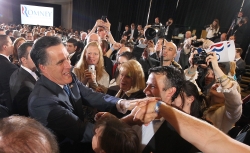Super PAC Hate-Spending
A majority of spending goes toward opposition. Here’s a state-by-state breakdown.

Justin Sullivan/Getty Images.
Unchecked Supper PAC fundraising and spending has resulted in an increasingly divisive political climate, with 54 percent of all money spent on opposition, mostly in the form of attack ads. The map below shows where Super PACs have fueled the most "hate" by state; hovering over markers reveals the percent spent on opposition out of total Super PAC spending. Tables on the right show a breakdown of spending in each state by candidate: The Restore Our Future PAC, which backs Mitt Romney, has spent 97 percent of its $31 million against Rick Santorum and Newt Gingrich. Explore the map to see who else is fueling this unprecedented political climate of hate.
About the Data
Data was collected from the Sunlight Foundation, which cleans up all independent expenditures reported by the Federal Election Committee. This data was sorted to filter out money spent on opposition, and grouped by Super PAC, candidate opposed, and state of expenditure. All maps made in open source design software Tilemill.
Background
On Jan. 21, 2010, the Supreme Court ruled in Citizens United v. FEC that corporations and unions could make unlimited independent election contributions so long as they complied with FEC disclosure regulations by registering as a political action committee. Two months later in March 2010, the D.C. Circuit Court of Appals ruled in Speechnow.org s. FEC that limits on contributions to PACs outlined in Federal Election Campaign Act violated the First Amendment. This created a provision for unlimited independent spending to advocate for the election or defeat of a federal candidate and has fundamentally shifted who holds the power and influence in the 2012 presidential election.